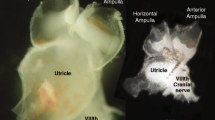Summary
Cells isolated from the guinea-pig vestibular sensory epithelia were studied using light- and electron-microscopic techniques. The cells maintained their characteristic shapes when they had been separated. Mammalian vestibular cells are traditionally divided into two classes, type-I and type-II hair cells. It was, however, found that the population of isolated cells consisted of hair cells with a striking variability in shape and size. This was most conspicuous for the type-I hair cells. Isolated hair cells processed for electron microscopy showed that the isolation process caused minor ultrastructural damage but that the separation often was incomplete in that the large calyx-like nerve endings were still attached to type-I cells. The results suggest that the distinction of only two classes might be insufficient to describe mammalian vestibular hair cells.
Similar content being viewed by others
References
Baird RA, Desmadryl G, Fernandez C, Goldberg JM (1988) The vestibular nerve of the chinchilla. II. Relation between afferent response properties and peripheral innervation patterns in the semi-circular canals. J Neurophysiol 60:182–203
Brownell WE, Bader CR, Bertrand D, Ribaupierre Y de (1985) Evoked mechanical responses of isolated cochlear hair cells. Science 227:194–196
Canlon B, Brundin L, Flock Å (1988) Acoustic stimulation causes tonotopic alterations in the length of isolated outer hair cells from the guinea pig hearing organ. Proc Natl Acad Sci USA 85:7033–7035
Correia MJ, Christensen BN, Moore LE, Lang DG (1989) Studies of solitary semicircular canal hair cells in the adult pigeon. I. Frequency- and time-domain analysis of active and passive membrane properties. J Neurophysiol 62:924–934
Didier A, Decory L, Cazals Y (1990) Evidence for potassium-induced motility in type-I vestibular hair cells in the guinea pig. Hearing Res 46:171–176
Dive C, Cox H, Watson JV, Workman P (1988) Polar fluorescein derivatives as improved substrate probe for flow cytoenzymological assay of cellular esterases. Mol Cell Probes 2:131–145
Favre D, Sans A (1984) Evidence for an organized lattice in the inter-cellular space of cat vestibular sensory epithelia. J neurosci Res 11:293–301
Flock Å, Flock B, Ulfendahl M (1986) Mechanisms of movement in outer hair cells and a possible structural basis. Arch Otorhinolaryngol 243:83–90
Goldberg JM, Desmadryl G, Baird RA, Fernandez C (1990) The vestibular nerve of the chinchilla. V. Relation between afferent discharge properties and peripheral innervation patterns in the utricular macula. J Neurophysiol 63:791–804
Hudspeth AJ (1989) Mechanoelectrical transduction by hair cells of the bullfrog's sacculus. Prog Brain Res 80:129–135
Jorgensen JM (1988) The number and distribution of caliceal hair cells in the inner ear utricular macula of some reptiles. Acta Zoologica (Stockh) 69:160–175
Kachar B (1985) Asymetric illumination contrast: a method of image formation for video light microscopy. Science 227:766–768
Ohmori H (1988) Mechano-electrical transduction in the chick hair cell. Prog Brain Res 74:11–20
Sans A, Brehier A, Moniot B, Thomasset M (1987) Immunoelectron microscopic localisation of “vitamin D-dependent” calcium-binding protein (CaBP-28K) in the vestibular cells of the cat. Brain Res 435:293–304
Scarfone E, Ulfendahl M, Flock Å (1989) Type-I vestibular hair cells undergo microtubule related shape changes. Abstracts of 26th Workshop of Inner Ear Biology, Paris, 3–6 September 1989
Scarfone E, Ulfendhal M, Figueroa L, Flock Å (1991) Anaesthetics may change the shape of isolated type-I hair cells. Hearing Res (in press)
Stöhr M, Vogt-Schaden M (1980) A new dual staining technique for simultaneous flow cytometric DNA analysis of living and dead cells. Flow Cytometry 4:96–99
Sugihara I, Furukawa T (1989) Morphological and functional aspects of two different types of hair cells in the goldfish sacculus. J neurophysiol 62:1330–1343
Valat J, Devau G, Dulon D, Sans A (1989) Vestibular hair cells isolated from guinea pig labyrinth. Hearing Res 40:255–260
Wersäll J, Bagger-Sjöbäck D (1974) Morphology of the vestibular sense organ. In: Kornhuber HH (ed) Handbook of sensory physiology, vol 6. Springer, Berlin Heidelberg New York, pp 123–170
Zenner HP (1986) Motile responses in outer hair cells. Hearing Res 22:83–90
Author information
Authors and Affiliations
Rights and permissions
About this article
Cite this article
Scarfone, E., Ulfendahl, M., Löfstrand, P. et al. Light- and electron microscopy of isolated vestibular hair cells from the guinea pig. Cell Tissue Res. 266, 51–58 (1991). https://doi.org/10.1007/BF00678710
Accepted:
Issue Date:
DOI: https://doi.org/10.1007/BF00678710




